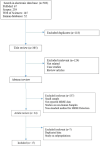A five-year systematic review and meta-analysis study on methicillin resistant Staphylococcus epidermidis strains in Iran
- PMID: 37069903
- PMCID: PMC10105277
- DOI: 10.18502/ijm.v15i1.11913
A five-year systematic review and meta-analysis study on methicillin resistant Staphylococcus epidermidis strains in Iran
Abstract
Background and objectives: One of the most prevalent drug-resistant bacteria is methicillin-resistant Staphylococcus epidermidis (MRSE) causing healthcare infections. Previously, a meta-analysis study on the frequency of MRSE was conducted from Mar 2006 to Jan 2016 in Iran. The present study aimed to evaluate the changes in this prevalence in the last 5 years in different cities in Iran.
Materials and methods: Published articles on the frequency of MRSE were collected from the Web of Science, PubMed, Scopus, Google Scholar, Cochrane Library, and Iranian databases from the beginning of 2016 to the end of 2020. Of the 503 records identified, 17 studies met the inclusion criteria, and their extracted data were analyzed using comprehensive meta-analysis version 2.0 (Biostat).
Results: The analysis showed that the frequency of MRSE has decreased significantly in the last five years and reached 60.8 [95% confidence interval (95% CI) 54.2-66.9] among culture-positive cases of S. epidermidis in Iran.
Conclusion: The noticeable reduction in the prevalence of MRSE in Iran could be due to the improvement of infection control programs and interruption of the pathogen transmission cycle. Another influential reason is the significant reduction in methicillin prescriptions by physicians for infections caused by staphylococci.
Keywords: Iran; Meta-analysis; Methicillin resistant; Staphylococcus epidermidis; Systematic review.
Copyright © 2023 The Authors. Published by Tehran University of Medical Sciences.
Figures




Similar articles
-
Correlation Between Biofilm Formation and Antibiotic Resistance in MRSA and MSSA Isolated from Clinical Samples in Iran: A Systematic Review and Meta-Analysis.Microb Drug Resist. 2020 Sep;26(9):1071-1080. doi: 10.1089/mdr.2020.0001. Epub 2020 Mar 10. Microb Drug Resist. 2020. PMID: 32159447
-
Prevalence of methicillin-resistant Staphylococcus aureus isolated from burn patients in Iran: A systematic review and meta-analysis.J Glob Antimicrob Resist. 2018 Mar;12:202-206. doi: 10.1016/j.jgar.2017.10.015. Epub 2017 Oct 28. J Glob Antimicrob Resist. 2018. PMID: 29107767
-
Environmental Contamination Prevalence, Antimicrobial Resistance and Molecular Characteristics of Methicillin-Resistant Staphylococcus Aureus and Staphylococcus Epidermidis Isolated from Secondary Schools in Guangzhou, China.Int J Environ Res Public Health. 2020 Jan 18;17(2):623. doi: 10.3390/ijerph17020623. Int J Environ Res Public Health. 2020. PMID: 31963695 Free PMC article.
-
Bacterial Ocular Infections in Iran: A Systematic Review and Meta-analysis.Oman Med J. 2023 Mar 31;38(2):e476. doi: 10.5001/omj.2023.22. eCollection 2023 Mar. Oman Med J. 2023. PMID: 37132006 Free PMC article. Review.
-
Dissimilarity of ccrAB gene sequences between methicillin-resistant Staphylococcus epidermidis and methicillin-resistant Staphylococcus aureus among bovine isolates in Korea.J Vet Sci. 2013;14(3):299-305. doi: 10.4142/jvs.2013.14.3.299. Epub 2013 Jun 30. J Vet Sci. 2013. PMID: 23820199 Free PMC article.
Cited by
-
Disinfectants efficacy in reducing pathogens related to health-care infection associated in universities hospitals of Gorgan, North of Iran.BMC Infect Dis. 2024 Oct 7;24(1):1113. doi: 10.1186/s12879-024-09985-8. BMC Infect Dis. 2024. PMID: 39375625 Free PMC article.
References
-
- Kalani BS, Khodaei F, Moghadampour M, Lotfollahi L, Ohadi E, Foroozeshfard M, et al. TRs analysis revealed Staphylococcus epidermidis transmission among patients and hospital. Ann Ig 2019; 31: 52–61. - PubMed
-
- Otto M. Staphylococcus epidermidis pathogenesis. Methods Mol Biol 2014; 1106: 17–31. - PubMed
Publication types
LinkOut - more resources
Full Text Sources
Miscellaneous
